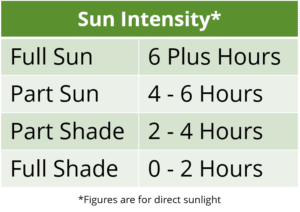Sun
Adequate sunlight for plants is essential, if they don’t get the sunlight they need they simply will not grow well. There are two things about the sun you need to know for your site analysis: the path and amount.
 First, you need to know the sun’s path over your property. To do this use the enclosed compass to find East and West. The sun will rise from the East and set to the West. Once you know the sun’s general path over your site, look for East-to-West areas that are sunny and shaded at various times of the day. Make a note of the sun exposures. The levels are: full sun, part sun, part shade, and full shade. Next, you need to determine how the sun’s path changes with the seasons. The sun is highest during the summer solstice, lowest during the winter solstice and between these points during the fall and spring equinoxes.
First, you need to know the sun’s path over your property. To do this use the enclosed compass to find East and West. The sun will rise from the East and set to the West. Once you know the sun’s general path over your site, look for East-to-West areas that are sunny and shaded at various times of the day. Make a note of the sun exposures. The levels are: full sun, part sun, part shade, and full shade. Next, you need to determine how the sun’s path changes with the seasons. The sun is highest during the summer solstice, lowest during the winter solstice and between these points during the fall and spring equinoxes.
The degree of change depends on your latitude: the farther north you are, the greater the shift. The closer you are to the equator, the smaller the shift. (If you are very close to the equator, you don’t need to read this lesson!)
You should spend some time determining how this southern shift will affect the amount of sun your garden receives at different times of the year. Account for seasonal shadows based on the sun shift, and determine which parts of your site get how much sunlight. Knowing these things will help you select, and place plants appropriate for your microclimate.
While it may seem a bit time consuming, try to draw a rough sketch of the summer and winter shady areas based on the path of the sun. You don’t need much precision; just try to get close. It can be a heartbreaker to invest a lot of time and money into a garden only to discover that it is full shade for half of the year. Some careful attention to the sun and its relation to your site will help you avoid situations like this, and will help you select plants that can thrive all year.
Now, having said that a lot of precision isn’t necessary, it bears saying that the more you know about the sun exposures on your site, the better you can plant with success. We provide detailed instructions on how to plot the amount of sun your garden site receives at any given time of day and over the course of a year. In the “Toolbox” area of the Garden Tutor site under “Sun Plotting” we provide detailed information so you can calculate sun exposures precisely, if you are so inclined.

General sunlight hints:
- Southern exposures are best for vegetables and plants that require lots of sun.
- Northern exposures receive the least sun.
- Morning sun is usually less intense than afternoon sun, so eastern exposures receive slightly less sunlight than western exposures.
- Between 10 and 2 P.M. the sun is at peak intensity. Plants that need full sun may thrive if they get direct sunlight during this time.
